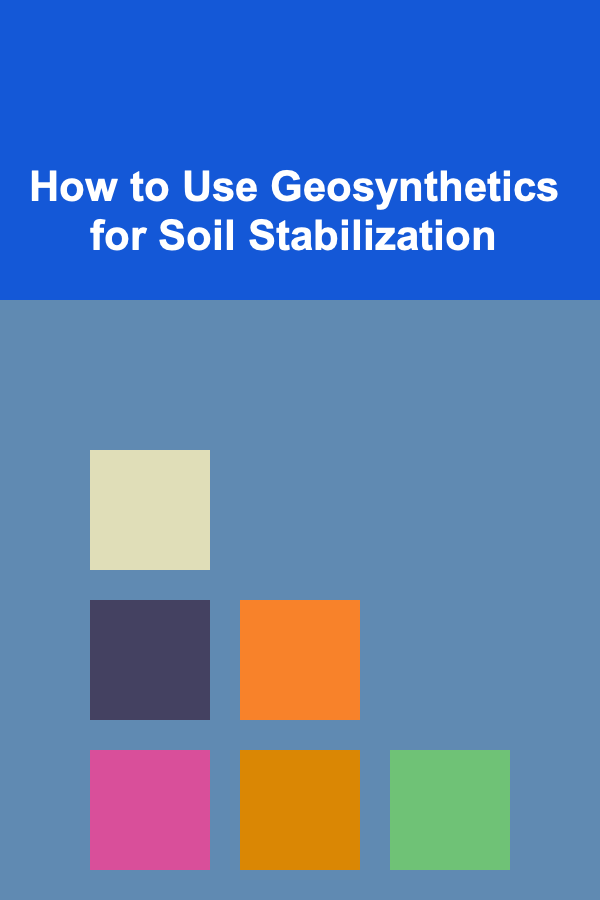
How to Use Geosynthetics for Soil Stabilization
ebook include PDF & Audio bundle (Micro Guide)
$12.99$10.99
Limited Time Offer! Order within the next:

Soil stabilization is a critical aspect of civil engineering and construction projects, ensuring the strength, durability, and functionality of infrastructure projects such as roads, embankments, and foundations. Traditionally, soil stabilization was achieved through mechanical compaction, cement, lime, or other stabilizing agents. However, with advancements in material science and technology, geosynthetics have become a revolutionary tool for soil stabilization.
Geosynthetics, a broad category of synthetic materials used in geotechnical and environmental engineering, offer several benefits over conventional methods. These materials, such as geotextiles, geomembranes, geogrids, and geocells, are used to improve the engineering properties of soil by enhancing its stability, strength, drainage, and filtration characteristics. The use of geosynthetics for soil stabilization has grown significantly due to their effectiveness, cost-efficiency, and sustainability.
In this article, we will explore how geosynthetics are used for soil stabilization, the different types of geosynthetics available, their advantages and limitations, and the practical applications in various construction and civil engineering projects.
What Are Geosynthetics?
Geosynthetics are synthetic materials that are used to solve geotechnical engineering problems. These materials are designed to perform specific functions such as filtration, separation, reinforcement, drainage, and containment. Geosynthetics are typically made from polymers like polyester, polypropylene, and polyethylene, which are known for their durability, resistance to environmental factors, and flexibility.
The main types of geosynthetics used in soil stabilization are:
- Geotextiles: These are permeable fabrics used to separate, filter, reinforce, or protect soil. Geotextiles are often used in road construction, drainage systems, and embankments.
- Geogrids: These are polymer grids used to reinforce soil by providing additional tensile strength. They are commonly used in retaining walls, base stabilization, and roadways.
- Geocells: These are three-dimensional honeycomb-like structures that help stabilize the soil and prevent erosion. Geocells are often used for slope protection and roadbed stabilization.
- Geomembranes: These are impermeable membranes used to contain or control the movement of water, often used in landfills, reservoirs, and other containment applications.
Each of these materials serves a unique purpose in soil stabilization, and the choice of which to use depends on the specific requirements of the project.
How Geosynthetics Aid in Soil Stabilization
The primary function of geosynthetics in soil stabilization is to enhance the soil's strength, prevent erosion, and increase the lifespan of infrastructure. Here's how geosynthetics contribute to soil stabilization:
a. Soil Reinforcement
One of the main benefits of geosynthetics is their ability to reinforce soil. Geogrids and geotextiles can be used to improve the shear strength of soil by providing additional tensile strength. These materials act like a matrix within the soil, distributing loads and reducing the tendency of soil to shift or settle under pressure.
In road construction, for example, geogrids can be placed in the subgrade layer to reinforce the soil and prevent differential settlement. This is particularly useful in areas with weak or unstable soil conditions.
b. Erosion Control
Soil erosion is a common problem in construction and environmental projects, particularly on slopes and embankments. Geocells and geotextiles can be used to reduce the erosion potential by providing a protective layer over the soil.
Geocells, for instance, form a three-dimensional structure that holds the soil in place, reducing surface runoff and preventing erosion caused by water flow. Similarly, geotextiles act as a barrier that allows water to drain while preventing soil particles from washing away.
c. Drainage Improvement
Geosynthetics also improve drainage in soil stabilization applications. Geotextiles and geomembranes are used to facilitate water flow while preventing soil clogging. This is crucial in applications like road construction, where proper drainage is essential to prevent water buildup, which can weaken the soil and compromise the stability of the structure.
In coastal and landfill applications, geomembranes are used to line the ground and create a waterproof barrier, preventing water infiltration and soil contamination.
d. Separation of Soil Layers
In construction, different soil layers often have varying properties, such as density, permeability, and strength. Geosynthetics, particularly geotextiles, are used to separate these layers to prevent mixing and ensure that each layer maintains its distinct properties. This separation is essential for maintaining the integrity and stability of the structure.
For example, in road construction, a geotextile may be placed between the subgrade and the aggregate base to prevent mixing and to improve the load-bearing capacity of the road structure.
e. Load Distribution and Compaction
Geosynthetics can help distribute loads more evenly across the soil, which is particularly beneficial in areas with weak or unstable soil. The use of geogrids in subbase stabilization allows for better compaction, improving the overall stability and performance of the structure.
In applications like parking lots or highways, geogrids are placed within the soil to enhance its load-bearing capacity and to prevent rutting or settlement caused by traffic loads.
Types of Geosynthetics for Soil Stabilization
There are various types of geosynthetics used for soil stabilization, each with distinct properties suited for different applications. The most commonly used types include:
a. Geotextiles
Geotextiles are widely used in soil stabilization due to their versatility and ability to perform various functions such as separation, filtration, reinforcement, and protection. Geotextiles can be classified into two main categories: woven and nonwoven geotextiles.
- Woven Geotextiles: Made from interwoven fibers, these geotextiles are typically used for reinforcement applications due to their high tensile strength. They are often used in road construction, embankments, and retaining walls.
- Nonwoven Geotextiles: Made from randomly arranged fibers, these geotextiles are primarily used for filtration and separation purposes. They are commonly used in drainage applications, such as in landfills or drainage ditches.
b. Geogrids
Geogrids are polymer materials that have an open, grid-like structure. They are used for soil reinforcement by improving the soil's tensile strength and providing additional support for soil structures. Geogrids are commonly used in the construction of retaining walls, embankments, and subgrade stabilization for roads and highways.
Geogrids work by distributing applied loads over a larger area of soil, preventing settlement and improving the overall stability of the structure. They are particularly effective in areas with weak or unstable soil.
c. Geocells
Geocells are three-dimensional cellular structures that can be used to stabilize soil and prevent erosion. These cells are typically filled with soil, gravel, or other materials to create a reinforced surface that is resistant to erosion and capable of supporting loads.
Geocells are ideal for applications such as slope protection, roadbed stabilization, and load support in areas where traditional methods might be less effective.
d. Geomembranes
Geomembranes are impermeable sheets used primarily for containment purposes. They are used in applications where water or other fluids need to be contained or controlled, such as in landfills, reservoirs, and ponds.
Geomembranes are also used for soil stabilization in areas where water infiltration could weaken the soil, such as in coastal areas or near water bodies. They prevent soil contamination and control the movement of water through the soil.
Advantages of Using Geosynthetics for Soil Stabilization
The use of geosynthetics for soil stabilization offers several advantages over traditional methods. Some of the key benefits include:
a. Cost-Effectiveness
Geosynthetics can be a more cost-effective solution compared to conventional soil stabilization methods. Traditional methods such as soil compaction or the use of cement or lime often require extensive equipment and labor, increasing the overall cost of the project.
Geosynthetics, on the other hand, are relatively easy to install and require less maintenance. Additionally, they can extend the lifespan of infrastructure, reducing the need for costly repairs in the future.
b. Environmental Benefits
Geosynthetics are often made from recyclable materials, which makes them a more sustainable option compared to traditional stabilization methods. They can help reduce the environmental impact of construction projects by minimizing the use of natural resources and reducing waste.
c. Increased Durability
Geosynthetics are highly durable and resistant to environmental factors such as UV radiation, moisture, and temperature fluctuations. This makes them ideal for use in harsh environments, such as coastal areas, landfills, and roadways subjected to heavy traffic.
d. Enhanced Performance
Geosynthetics can improve the performance of soil in a variety of ways. They enhance soil strength, prevent erosion, and improve drainage, which contributes to the overall stability and longevity of infrastructure projects.
Applications of Geosynthetics in Soil Stabilization
Geosynthetics have numerous applications in soil stabilization across various sectors of construction and civil engineering. Some of the most common applications include:
a. Road Construction
In road construction, geosynthetics are used to reinforce the soil, improve drainage, and prevent erosion. Geotextiles and geogrids are commonly used in roadbed stabilization to enhance the load-bearing capacity of the soil and prevent settlement or rutting caused by traffic.
b. Slope Protection
Geocells and geotextiles are often used for slope stabilization and erosion control. By providing a protective barrier, these materials help prevent soil erosion caused by water runoff and reduce the risk of landslides or slope failure.
c. Embankment Construction
Geosynthetics are used in embankment construction to reinforce the soil and improve its stability. Geogrids are often used to provide tensile strength and prevent settlement, while geotextiles are used to separate different soil layers and improve drainage.
d. Landfills and Waste Containment
Geomembranes are commonly used in landfills to provide a waterproof barrier that prevents the movement of liquids or contaminants through the soil. These materials help protect the surrounding environment from pollution and ensure that the landfill remains stable.
Challenges and Limitations of Geosynthetics in Soil Stabilization
While geosynthetics offer many advantages, there are also some challenges and limitations to their use. Some of these include:
- Installation Challenges: The proper installation of geosynthetics requires trained professionals, as improper installation can compromise the effectiveness of the materials.
- Material Compatibility: Not all geosynthetics are compatible with all types of soil or environmental conditions. It is important to select the right material for the specific project.
- Cost of High-Quality Materials: While geosynthetics are generally cost-effective, high-quality materials can be expensive, and this may limit their use in certain projects.
Conclusion
Geosynthetics have proven to be an effective and innovative solution for soil stabilization, offering several benefits such as increased durability, cost-effectiveness, and environmental sustainability. By reinforcing soil, improving drainage, preventing erosion, and separating soil layers, geosynthetics play a vital role in ensuring the stability and longevity of infrastructure projects. As the construction industry continues to evolve, geosynthetics will remain a valuable tool for engineers and builders seeking sustainable and efficient solutions for soil stabilization.
Reading More From Our Other Websites
- [Mindful Eating Tip 101] From Cravings to Conscious Choices: A Practical Mindful Eating Checklist
- [Organization Tip 101] How to Organize Your Photography Equipment at Home
- [Home Budget 101] How to Create a Meal Planning Budget to Save on Groceries
- [Stamp Making Tip 101] Creative Stamp-Making Techniques to Elevate Your Handmade Greeting Cards
- [Beachcombing Tip 101] Shell Hunting 101: Tips for Finding and Identifying Ultra‑Rare Sea Shells
- [Organization Tip 101] How to Create a Home Office That Inspires Productivity
- [Home Budget Decorating 101] How to Create a Cozy Space on a Budget in Your Bedroom for Better Sleep
- [Biking 101] Bike Stem Explained: What It Does and Why It's Important
- [Gardening 101] Kitchen Garden Hacks: How to Maximize Your Harvest in Limited Space
- [Personal Investment 101] Earning Money with AI: How to Make Passive Income with Deep Learning

How to Create a Checklist for Setting Up Customer Support Channels During Onboarding
Read More
How to Price for International Markets in Your Dropshipping Store
Read More
Navigating Fleet Compliance: Laws, Regulations, and Best Practices for Effective Fleet Managers
Read More
How To Introduce History Concepts Through Storytelling
Read More
How to Break Bad Habits for Good
Read More
How to Create a Video Game To-Do List for Specific Challenges
Read MoreOther Products

How to Create a Checklist for Setting Up Customer Support Channels During Onboarding
Read More
How to Price for International Markets in Your Dropshipping Store
Read More
Navigating Fleet Compliance: Laws, Regulations, and Best Practices for Effective Fleet Managers
Read More
How To Introduce History Concepts Through Storytelling
Read More
How to Break Bad Habits for Good
Read More